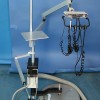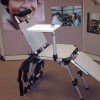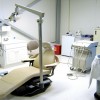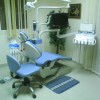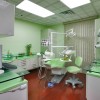Jeff Wilson Everyday DIY Blog
Let's talk DIY
This is the place to rant, rave, brag, belly-ache, crack a joke, procrastinate, and delve into the metaphysical aspects of the DIY mindset. We’re off the map, on a tangent, and frequently off topic. This is the stuff we don’t show on TV.
Parking Gates
Parking gates are a type of access control hardware. They are commonly used in parking lots. Many parking lots which have gates are paid lots, meaning the driver of the vehicle has to pay to park in that particular lot. A typical configuration of a parking gate involves two sets of gates, one at the entrance and one at the exit. The set of gates at the entrance usually requires the driver of the vehicle to pull up in front of the gate and retrieve a ticket from a cabinet; once the ticket is distributed, the gate opens to allow access to the parking lot. When the driver is ready to leave, he or she drives up to the second set of gates which is located at the lot exit, and submits payment either directly to an attendant or through an automated system. Once the driver has paid, the gate opens.
Refrigerated Display Equipment
Refrigerated display equipment is used to enhance product presentation and keep food at safe temperatures. 'Medium temperature merchandisers' is another term used for refrigerated display cases. They can typically be found in supermarkets, convenience stores, delis, bakeries and sushi bars. Refrigerated display cases can be either service, which involves an attendant handling the product, or self-service, where the customer handles the product. Generally, they can be classified as three types of cases: grab-n-go, reach-ins and countertop units. Grab-n-go units are self-service and are commonly found in supermarkets and convenience stores. They can be used for various products, such as produce, drinks, sandwiches, dairy, and others. Grab-n-go cases are open cases that can be wall units or island type cases. Reach-in cases typically have glass doors, and can also be found in supermarkets and convenience stores. They are used for products that require a steady temperature such as milk, eggs and other dairy products. Countertop units are used mainly for sushi and similar applications.
Unit Kitchens
Unit kitchens are commonly used in instructional settings such as culinary schools, junior high and high schools. They are designed to re-create home/restaurant cooking conditions for each student. Unit kitchens were first introduced in 1916 for use in home-economics classrooms. The unit kitchen allowed for actual training in a “real kitchen”. The design of each unit in a high school, for example, would either be a small three sided room or a u-shaped area with essential cooking equipment. Typically the equipment would include a sink, stove, work space, and necessary utensils. The design would allow open area for the instructor to supervise the activities. Later, as culinary/cooking schools emerged, they adapted the unit kitchen idea for the “real restaurant kitchen” experience.
Foodservice Equipment
Foodservice equipment can be defined as any piece of equipment that is used for or with commercial food preparation. Foodservice equipment can be found in various types of establishments, such as restaurants, delis, supermarkets, institutions, and schools. It involves a wide variety of products, from food preparation equipment to finishing units. Some examples of foodservice equipment are: reach-in refrigerator/freezers, commercial ovens, proofers, broilers/ salamanders, grilles, ranges, stainless steel tables, sandwich prep stations, and pizza ovens.
Walk-In Coolers
Walk-in coolers are defined as an engineered, refrigerated storage room. They can be found in restaurants, food storage facilities, convenience stores, and research laboratories. A walk-in cooler should be able to maintain a temperature as low as 35 degrees F. They are pre-engineered or pre-fabricated units that come in both standard and custom sizes. Custom walk-in coolers can be manufactured to meet specific size and shape requirements.
Entertainment Equipment
Entertainment equipment includes any installed equipment that is used for entertainment purposes. This equipment is usually large in scale and has to be coordinated with the architecture and engineering of the building structure.
Rigging Systems and Controls
Rigging systems and controls have been used in theaters since as early as the 15th century. Originally the rigging consisted of wood pulleys and sand bags. Sailors were typically hired to operate the rigging because of their experience with ropes and heights. Today's modern rigging consists of steel sheaves, wire cables and steel counterweights. Fly towers and catwalks are used to run the rigging, lights and curtains. Many of today's systems are motorized and computer operated. Design and installation of stage rigging and equipment should be done by a professional to insure proper function and safety.
Playground Equipment
Playground equipment is recreational indoor and outdoor equipment designed to help children develop physical coordination, strength and flexibility while playing. Playgrounds provide an environment that encourages a child to develop both physically and mentally. Playground equipment is typically constructed from wood, metal or plastic. The use of plastic is becoming increasing popular because it is a softer material, is easier to install, and is available in a wide variety of colors to captivate a child's visual sense.
Dental Equipment
Dental equipment includes the installed permanent equipment needed for use by dentists, oral surgeons, and orthodontists. This equipment includes, but is not limited to, dental chairs, x-ray machines, x-ray viewers, and specialized lighting. Most of this equipment has specific engineering and architectural requirements that should be considered when designing and engineering a dental environment. New technology is being developed constantly to improve the quality of patient care. Designing environments that can grow and change with technology is essential.
Baptisteries
Baptisteries were originally created when the church moved the ceremony of baptism from large, outdoor bodies of water to the inside of religious facilities. Baptisteries can be large enough for two people to occupy the space while one of the occupants is completely submerged, or baptism can be done in front of a baptismal font, which is a smaller, more portable furnishing, usually used for baptising babies.
